'One woman, one egg' IVF plan reduces chances of live births
Thousands of childless couples will be hit by attempt to cut twins and triplets born as result of fertility treatment

Thousands of couples undergoing IVF treatment will find that their chances of having a baby are vastly reduced under a controversial new technique being promoted by the fertility watchdog, the Human Fertilisation and Embryology Authority (HFEA).
The authority is trying to cut the number of IVF twins and triplets by reducing the number of eggs implanted in mothers-to-be from two to one.
This process is known as Single Embryo Transfer (SET). But findings from the first research into the use of SET reveal that it slashes the chances of a successful live birth to just 17 per cent.
If the preliminary findings are correct, the average 30-year-old woman undergoing IVF will see her chances of having a baby reduce from 30 per cent to 21 per cent according to the study. And a 40-year-old woman would see her chances fall from 14 per cent to 9. The results are based on a two-year study of 110,000 patient records for the Department of Health, which will publish the study next year.
Dr Steve Roberts, a biostatistician from Manchester University and St Mary's Hospital, presented the findings at a conference held in London yesterday. He warned that patients are already suffering because cash-strapped primary care trusts (PCTs) do not offer the three cycles of treatment recommended by the National Institute for Clinical Excellence (Nice).
"In terms of a live birth rate from a single embryo transfer, you're losing something between a quarter and a third from the previous success rate. This is right across the board – everybody loses. There's been spin around SET in terms of downplaying the fact that you're going to reduce success rates," he said.
"I think the issue is going to be about compensating for the reduced success rate by giving people the number of cycles that Nice recommends, which is not currently happening."
In-depth interviews with couples undergoing IVF, carried out as part of the study, reveal mounting concern that SET will leave many people childless.
"For a lot of patients, twins are the ideal outcome, even if they are aware of the risks and they think they are acceptable," Dr Roberts said. "There's a big issue about choice; people are scared about losing their choice through SET. They want to maximize their chances, but someone's got to square this circle, and the Nice guidelines need to be implemented properly."
The news comes a year after this newspaper revealed the HFEA's plans to introduce SET. Government targets call for clinics to reduce the number of multiple births from IVF pregnancies from the current rate of 25 per cent to 10 per cent by 2012.
The HFEA and the Department of Health have sent out stern letters reminding health trusts to follow the guidance on three cycles after repeated failures. Professor Robert Edwards, who pioneered IVF 30 years ago, said: "It doesn't make me sad that people can't get funding for IVF, it makes me angry. I'd like to see everyone have four or five cycles if they need it. I feel very sad that people can't have children, and they should have the right to have a chance."
Clare Brown, chief executive of Infertility Network UK, said: "It is appalling that many couples are still unable to access NHS treatment.
"The biggest issue in infertility treatment today is the postcode lottery of IVF treatment."
A spokesman for the HFEA said: "Nobody in the UK is suggesting that SET is a one-size-fits-all approach for all patients. Doctors are telling us that if you pick the right patients, SET doesn't affect success rates."
Subscribe to Independent Premium to bookmark this article
Want to bookmark your favourite articles and stories to read or reference later? Start your Independent Premium subscription today.

Join our commenting forum
Join thought-provoking conversations, follow other Independent readers and see their replies
Comments